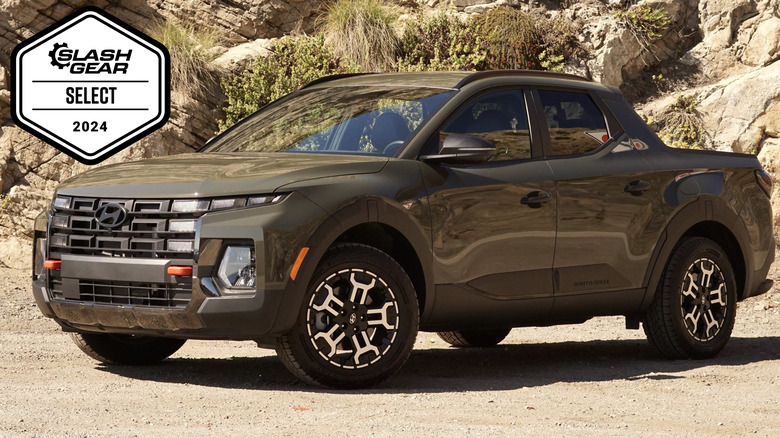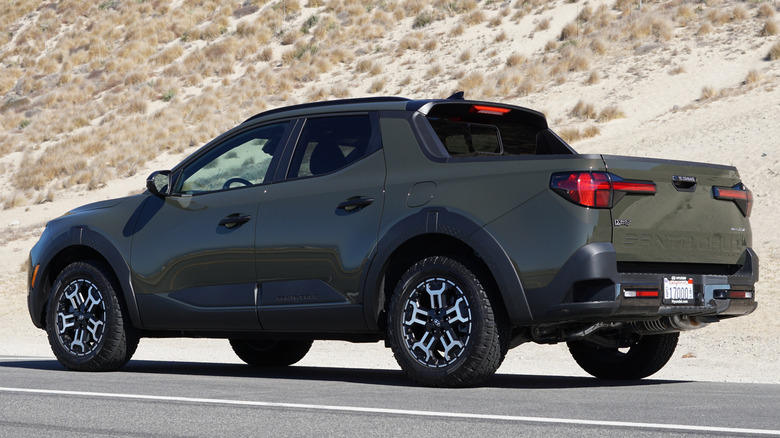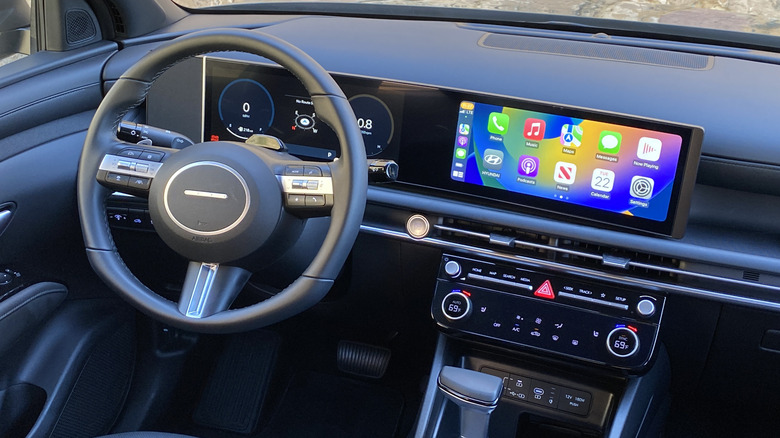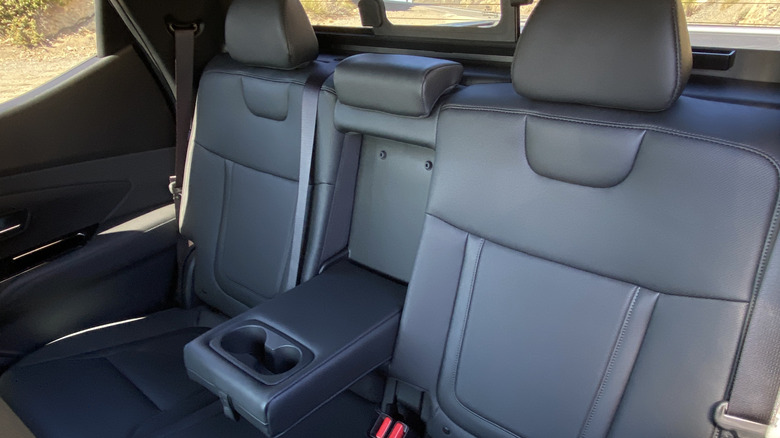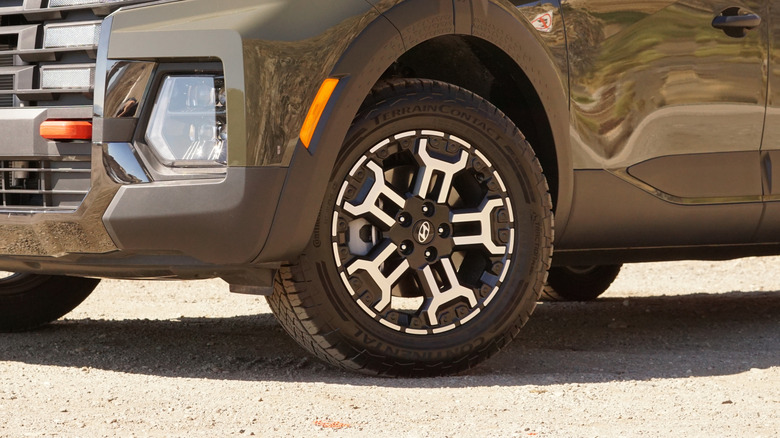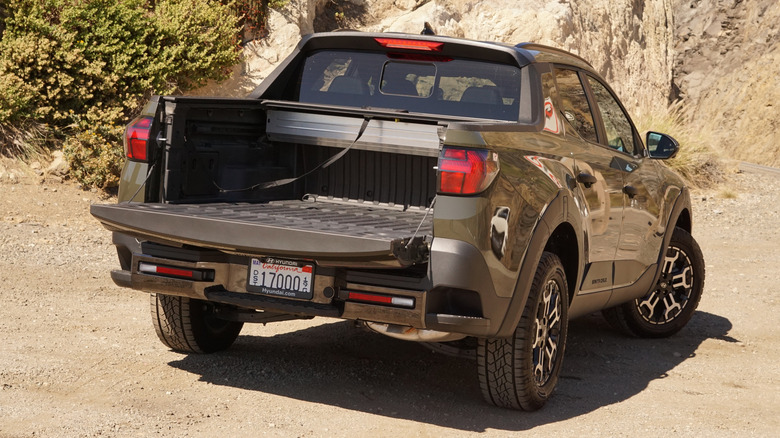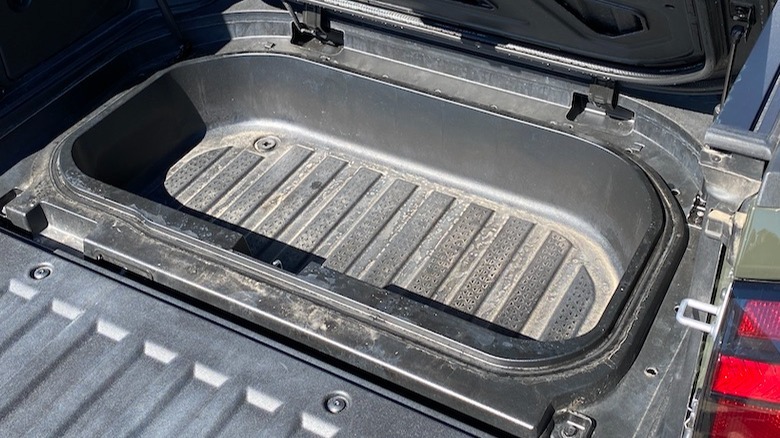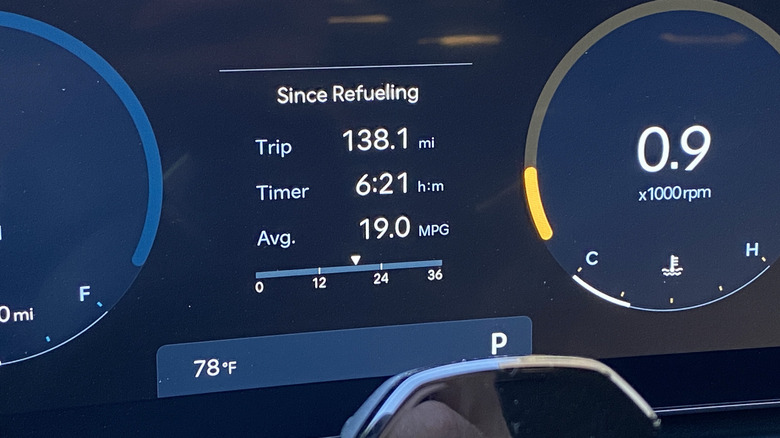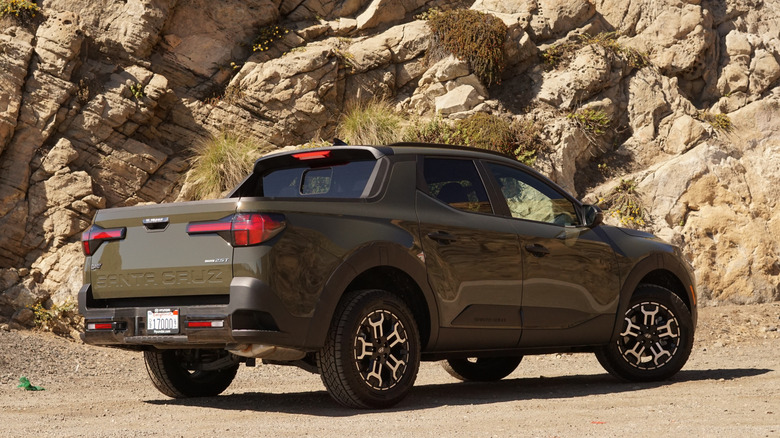2025 Hyundai Santa Cruz Review: A Style-Forward Truck With One Big Issue
- Impressive infotainment interface
- Quiet and comfortable ride
- Peppy turbocharged engine
- Still no hybrid powertrain
- Underwhelming base engine
- Steering and handling could be better
If you want something utilitarian, relatively small, easy to drive, with a few pickup truck features, the 2025 Hyundai Santa Cruz should be near the top of your list. Based on the same platform as the Tucson SUV, the Santa Cruz is Hyundai's version of a small pickup truck (and it just so happens to top the list of smallest trucks currently available in the United States). It comes exclusively in a crew-cab configuration and it offers the utility of a small pickup-truck bed along with meaningful stats like a towing capacity as high as 5,000 pounds.
The 2025 Santa Cruz has no shortage of modern tech and a full suite of standard safety features, and it's available with a peppy turbocharged engine that gives it some extra driving character. Underneath, it uses unibody construction that's more like a traditional car or crossover-SUV, which means it has an impressively smooth ride and a quiet interior. Traditional midsize pickup trucks use body-on-frame construction which is more robust, but has drawbacks when it comes to comfort and efficiency.
Trucks like the Tacoma, Frontier, Ranger, and Colorado all outperform the Santa Cruz when it comes to tasks like towing and hauling, but they have a hard time keeping up when it comes to fuel economy and overall comfort. Thankfully, the Santa Cruz has some serious competitors amongst unibody pickups, in the form of the Ford Maverick and the Honda Ridgeline – both of which offer unique appeal.
Get the optional turbocharged engine
There are two engines to choose from with the 2025 Santa Cruz. The first is a 2.5-liter four-cylinder paired with an eight-speed automatic transmission that puts out 191 horsepower and 181 lb-ft of torque. Most trim levels come standard with this engine and it has adequate power, but isn't what I would describe as exciting. The optional engine is a turbocharged 2.5-liter four-cylinder with much more grunt: 281 hp and 311 lb-ft of torque. The optional turbocharged engine feels very lively in comparison, especially with the quick shifts from the eight-speed dual-clutch transmission.
Steering and handling aren't the Santa Cruz's strongest suits, but they're certainly acceptable for the class. Steering is well weighted, maybe a bit heavier than you'd expect, but handling is uninspiring. Braking feels a bit underwhelming too — the Santa Cruz's brakes work just fine but pedal feedback is minimal. The turbocharged engine under the hood of the Santa Cruz hints towards an especially sporty character so I was under the impression that it would be rewarding to drive on a curvy mountain road. Sadly, it wasn't. The all-terrain tires certainly contributed to a lack of canyon-carving capability, but on the twisty back roads is not where this modern-ute shines.
Tech and interior usability are way up
The user interface on the Santa Cruz's new screens is excellent. In base trims, the driver gets a 4.2-inch driver display next to the 12.3-inch center screen, but on upper trims like the XRT I drove, things are much better. Side by side, on SEL Activity trims and above, there are two 12.3-inch screens – one for the driver, the other for the infotainment; both are easy to read and operate. The center touchscreen responds to commands quickly, has clear graphics and is well organized. Over a week behind the wheel, all the command locations felt intuitive and all the buttons felt easy to find. Wireless Apple CarPlay and Android Auto are standard on every trim level of the Santa Cruz and smartphone connectivity was a breeze.
There are a few small drawbacks on the interior of the Santa Cruz though. There are plenty of places for small-item storage, but they aren't optimized for the items you typically carry. There are lots of cup holders, for example, but don't pack your big Nalgene bottle. The back-door and back-seat center console holders are only adequately sized for soda cans, but not much more. The six-speaker stereo also isn't particularly impressive, especially when it comes to max volume where bass cuts out and clarity isn't very top notch. An upgraded Bose stereo is available, but only on top-trim Limited models.
A comfortable ride but try to sit up front
The Santa Cruz is amongst the most comfortable trucks in its class. On the highway and over broken city streets the ride is smooth and forgiving. Even with the beefed-up all-terrain tires, the Santa Cruz XRT still has a quiet cabin. At freeway speeds the road noise from the all-terrains is kept to a minimum. There's a slight whiff of wind noise from the large rear view mirrors at highway speed, but it can easily be drowned out with a bit of music.
After several hours behind the wheel, the front seats still felt just as comfortable and well-padded as when I first sat down. The rear seats are a bit firmer though and they're better left for occasional use. With 36.5 inches of rear legroom, there's plenty of room back there for adults, and the Santa Cruz is within half an inch of the Ridgeline (36.7) and Maverick (36.9) so none of these trucks has a distinct advantage when it comes to rear legroom. Still, the Hyundai's rear seats are pretty upright, which may take its toll on long road trips. It should be noted, though, that the Ridgeline is significantly wider than the Santa Cruz and the Maverick, so rear-seat passengers will be able to spread out a bit more with the Honda.
More off-road capability via the XRT trim
While the Santa Cruz isn't likely to be spotted on the world's toughest terrain, it's totally capable enough to get you off the beaten path and into the wilderness a bit. Like previous versions of the pickup, this year's model has 8.6 inches of ground clearance – enough to get you over most small obstacles. The XRT trim also gets a unique front bumper which improves the approach angle too, going from 16.9 degrees to 19.9. This increase means you're less likely to scrape on an obstacle as you drive up to it – a big plus if you spend a lot of time in the dirt.
Then, there are the all-terrain tires which give it more grip in slippery off-road scenarios, and the two front tow hooks which should help if you happen to get your Santa Cruz stuck. The Santa Cruz XRT shows some promise in the off-roading department, even if it hasn't made the full jump to taking over the outdoors. Thankfully, it's adept at off-roading on mild trails and it's more than capable of dealing with tough weather conditions like snow.
Figuring out the truck stuff
The bed on the Santa Cruz isn't very large, but it's still useful. It measures just 42.7 inches wide between the wheel wells, so you'll need to stack plywood on top of those protrusions. With the tailgate down, the bed is 74.8 inches in length: definitely enough to carry a few sheets of wood on occasion.
Inside the bed, the Santa Cruz has a shallow storage bin, designed with a few removable plugs for drainage. Much like the storage bin in the Ridgeline, this area can be used for storing ice and drinks during a tailgate party, or for rinsing off your muddy clothes after a day of mountain biking. The Ridgeline's in-bed storage however, is more accessible. Honda offers a standard dual-action tailgate that swings open sideways, allowing you to get much closer to the storage bin. Also, Honda's bin is much deeper for quite a bit more storage.
The max payload for the Santa Cruz checks in at 1,411 pounds – a respectable number for a small pickup, but lower than the 1,500-lb max payload offered by the Maverick and the 1,583 lbs offered by the Ridgeline. All-wheel drive models can tow as much as 5,000 pounds which is right in line with the other unibody options in the class, even though it is significantly lower than midsize body-on-frame trucks (the best of the midsize bunch can tow over 7,000 pounds).
Putting the fuel economy in context
Fuel economy with the Santa Cruz is all about context. A front-wheel drive version of the truck with the base engine is rated at 25 mpg combined by the EPA. That's respectable amongst midsize pickup trucks like the Chevy Colorado, Nissan Frontier, and even the Honda Ridgeline – none of which meet that mark. Even the hybrid-powered Toyota Tacoma only has a top rating of 24 mpg combined. There is, however, a truck that outdoes them all – the Ford Maverick.
The Ford Maverick is available with a 2.0-liter four-cylinder engine but it's also available as a hybrid, using an electrified 2.5-liter four-cylinder to achieve a rating of 37 mpg combined (42 city/33 highway) with front-wheel drive models. Official ratings aren't in yet for the 2025 Maverick, but the new all-wheel drive hybrid is expected to get similarly-high ratings (Ford says it's targeting 40 mpg city).
The XRT is the bottom of the Santa-Cruz barrel when it comes to Santa-Cruz fuel economy ratings. According to the EPA, it will return 21 mpg combined (18 city/26 highway). During my time behind the wheel, I averaged about 19 miles per gallon. That's not surprising when you consider the effects that all-terrain tires typically have on fuel economy. The off-road version of the Ford Maverick, called the Tremor, has a similar rating of 21 mpg combined (20 city/24 highway). The Ridgeline checks in at 21 mpg combined on standard models, and 20 mpg combined on off-road-oriented TrailSport models.
2025 Hyundai Santa Cruz Verdict
With its styling refresh for 2025, the big additions to interior tech, and the increase in off-road talent, the Santa Cruz is more appealing than ever. It offers more refinement and a better daily driving experience than most midsize pickup trucks, even if it isn't as practical. Off-road capability will likely surprise most buyers, and the versatile bed is more than just a party trick. Daily driving a Santa Cruz is a stress-free experience due to the easy to use infotainment interface, the quiet and comfortable interior, and the gutsy turbocharged powertrain.
Unfortunately, the Santa Cruz is still missing an available hybrid powertrain, and that's a distinction that makes the Ford Maverick a wiser choice for frugal buyers. The Santa Cruz also tied for last when it comes to towing capability in its class and it's at the bottom of the ladder for overall payload. These drawbacks shouldn't be deal breakers though, considering all that the Santa Cruz has to offer.
